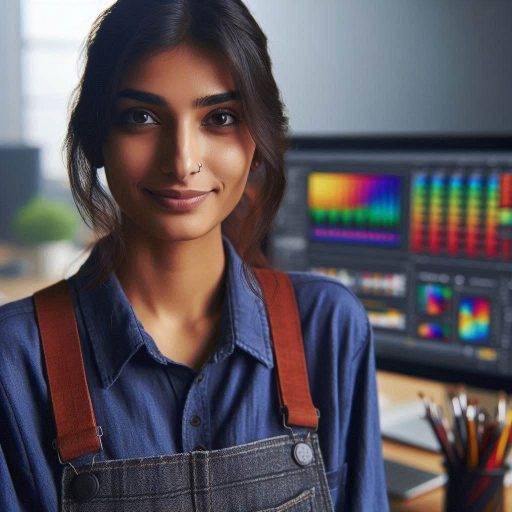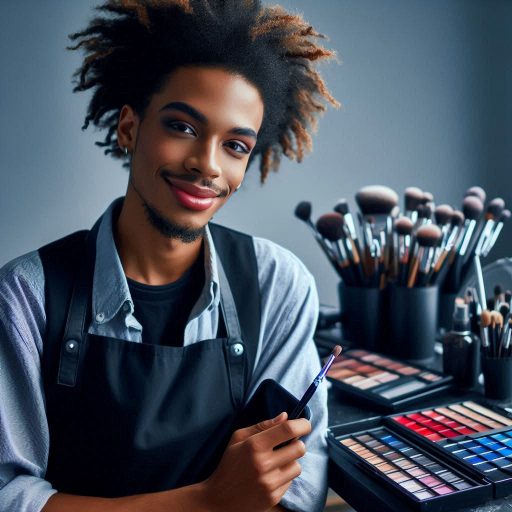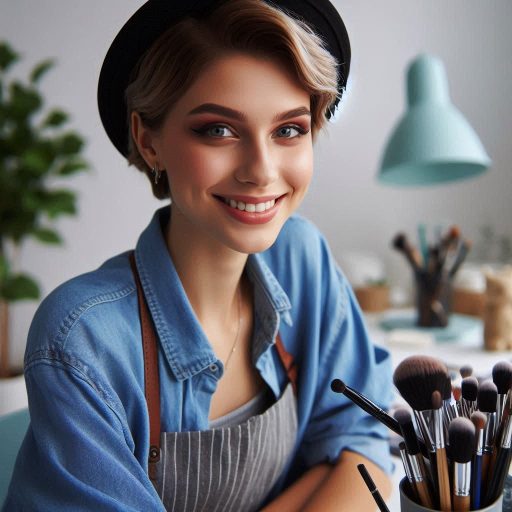Introduction
Art history profoundly influences modern makeup trends.
For centuries, makeup and art have intertwined, shaping beauty standards and creative expression.
Ancient Egyptian makeup, with its bold eye lines and vibrant colors, mirrors their artistic stylization.
Cleopatra‘s use of kohl eyeliner is a testament to how makeup was used for aesthetic and symbolic purposes.
In the Renaissance, artists like Titian and Botticelli depicted women with radiant, flawless complexions.
These depictions influenced makeup trends, emphasizing natural beauty and glowing skin.
The Baroque era‘s dramatic use of color and contouring can be seen in today‘s makeup techniques, such as contouring and high-definition makeup.
The 20th century‘s art movements, such as Art Deco and Pop Art, also shaped makeup trends.
Art Deco‘s elegance and geometric shapes inspired sleek, bold makeup styles, including sharp eyeliner and defined lips.
Meanwhile, Pop Art‘s vibrant colors and graphic elements influenced makeup artists to experiment with bright hues and graphic designs.
Modern makeup trends often draw from these historical influences, blending traditional art aesthetics with contemporary techniques.
Today‘s makeup artists continue to look to art history for inspiration, creating innovative looks that pay homage to past artistic styles.
Thus, the connection between art and makeup remains a dynamic and evolving relationship, reflecting both historical artistry and modern creativity.
Ancient Art Influence
How ancient civilizations like Egypt and Mesopotamia used makeup for religious and cultural purposes
Ancient civilizations like Egypt and Mesopotamia used makeup for religious and cultural purposes.
Egyptians applied makeup as an expression of beauty and status.
They used kohl to outline their eyes, believed to protect against evil spirits.
Mesopotamians similarly used eye makeup and lip color in their daily routines.
These early techniques have significantly influenced modern makeup trends.
How these early makeup techniques have influenced modern makeup trends
The Egyptians‘ iconic kohl eyeliner remains a staple in today‘s beauty routines.
Modern makeup artists often use similar techniques, incorporating bold eye definitions.
Transform Your Career Today
Unlock a personalized career strategy that drives real results. Get tailored advice and a roadmap designed just for you.
Start NowEgyptian influence extends to the use of vibrant eyeshadows and eyeliners, reflecting the boldness seen in ancient art.
Mesopotamian practices also leave a mark on contemporary makeup.
Their use of natural pigments for lip color can be seen in today’s lipsticks and glosses.
Modern products often use colors and textures reminiscent of ancient formulas.
The use of natural, mineral-based ingredients in both ancient and modern makeup highlights a continued appreciation for natural beauty.
Examples of specific makeup techniques inspired by ancient art
One specific example is the resurgence of green eyeshadows, which echoes the green malachite used by Egyptians.
Modern beauty products often incorporate this historical hue into eyeshadow palettes.
Similarly, the use of gold in highlighters reflects the ancient Egyptians’ fondness for this precious metal.
This timeless allure underscores how ancient beauty practices continue to inspire today‘s trends.
Ancient art’s influence on modern makeup is evident in these lasting techniques and aesthetics.
By blending historical inspiration with contemporary innovation, makeup artists create looks that honor past traditions while embracing the present.
Read: Innovative Makeup Techniques and Trends
Renaissance Art Influence
How the Renaissance era changed beauty standards and makeup trends
During the Renaissance era, beauty standards and makeup trends underwent significant transformations.
Artists like Leonardo da Vinci and Botticelli played a crucial role in depicting beauty through their paintings.
The Renaissance period, known for its revival of art, culture, and humanism, brought forth a new appreciation for beauty.
This era marked a shift from the Medieval times, where simplicity and modesty were valued.
How famous artists like Leonardo da Vinci and Botticelli depicted beauty in their paintings
Artists of the Renaissance, such as Leonardo da Vinci, renowned for his masterpiece, the Mona Lisa, portrayed women with ethereal beauty.
Their soft features, delicate skin, and subtle makeup highlighted a sense of grace and elegance.
Botticelli, another prominent artist of the Renaissance, depicted idealized versions of beauty in his paintings.
Showcase Your Business Today
Reach thousands of readers actively exploring professional services. Publish your business profile and grow your audience now.
Publish NowHis famous work, The Birth of Venus, showcased women with luminous skin, rosy cheeks, and flowing hair, embodying a sense of purity and grace.
How these ideals have influenced modern makeup looks, such as the emphasis on natural beauty
The influence of Renaissance art on modern makeup looks can be seen in the emphasis on natural beauty.
The era’s portrayal of soft, radiant skin, flushed cheeks, and subtle enhancements has inspired contemporary makeup trends that focus on enhancing one’s features rather than masking them.
Modern makeup techniques, such as “no-makeup” makeup looks, where the goal is to achieve a natural, flawless complexion, reflect the Renaissance ideals of simplicity and elegance.
The use of sheer, luminous products to create a dewy finish mirrors the soft, ethereal glow seen in paintings from this era.
Furthermore, the emphasis on enhancing individual features, like defined brows, flushed cheeks, and subtly highlighted eyes, echoes the Renaissance artists’ attention to detail and craftsmanship in depicting beauty.
This approach to makeup celebrates uniqueness and embraces imperfections, mirroring the humanistic values of the Renaissance period.
In fact, the influence of Renaissance art on modern makeup is undeniable.
The era’s depiction of beauty in paintings by artists like Leonardo da Vinci and Botticelli has shaped contemporary beauty standards and trends, emphasizing natural beauty, individuality, and a sense of grace and elegance.
Read: How to Keep Up with SFX Industry Trends

Impressionism Influence
How the Impressionist movement challenged traditional beauty standards
The Impressionist movement revolutionized beauty standards in art.
Before Impressionism, beauty was idealized, often featuring flawless, unrealistic depictions.
Impressionists like Claude Monet and Edgar Degas challenged these norms.
Their work presented women in a more authentic and unembellished light.
How artists like Monet and Degas portrayed women in a more natural and realistic way
Monet’s paintings, such as “Woman with a Parasol,” captured everyday moments.
His portrayal of women was natural and candid, reflecting their true selves.
Similarly, Degas’s works, like “Ballet Rehearsal,” showcased women in motion and everyday settings.
These depictions emphasized reality over idealized beauty.
How this shift in representation influenced modern makeup trends
This shift towards realism in art resonated beyond the canvas.
The focus on naturalness influenced modern makeup trends.
The rise of the ‘no-makeup’ makeup look exemplifies this change.
This trend aims to enhance, not mask, one’s natural features.
It emphasizes subtlety and authenticity, mirroring the Impressionist ethos.
In modern makeup, products aim to achieve a fresh, natural appearance.
Techniques such as minimal coverage and natural tones reflect this artistic influence.
The goal is to highlight natural beauty rather than conceal it.
Impressionist art set a precedent for valuing authenticity and simplicity in beauty.
The Impressionist movement’s impact on makeup trends is profound.
By challenging traditional beauty standards and embracing realism, it reshaped how beauty is perceived and portrayed.
Today‘s makeup trends continue to draw inspiration from this artistic shift, celebrating natural beauty and authenticity.
Read: Understanding the Art and Design of Makeup
Pop Art Influence
How the bold colors and graphic design of the Pop Art movement have influenced makeup trends
Pop Art, with its vibrant colors and bold graphic styles, has had a significant impact on modern makeup trends.
This movement, popularized in the 1950s, revolutionized the art world and continues to inspire creativity in various fields, including makeup artistry.
How artists like Andy Warhol and Roy Lichtenstein inspired creative and avant-garde makeup looks
When we think of Pop Art, we often think of artists like Andy Warhol and Roy Lichtenstein, whose iconic works have become symbols of the movement.
Their use of bright, eye-catching colors and contrasting patterns has influenced makeup artists to experiment with similar concepts in their creations.
One of the key elements of Pop Art that has translated into makeup trends is the use of bold and unconventional colors.
Makeup enthusiasts have embraced vibrant hues like electric blue, neon pink, and lemon yellow in their eyeshadow palettes and lipsticks, creating dynamic and striking looks reminiscent of Pop Art masterpieces.
In addition to colors, the graphic design principles of Pop Art have also made their way into the world of makeup.
Artists have taken inspiration from Lichtenstein’s comic book-style dots and Warhol’s repetition of images to create innovative and avant-garde makeup looks.
Techniques such as graphic eyeliner, pixelated lips, and exaggerated lashes have become popular among those seeking to make a statement with their makeup.
Showcase Your Business Today
Reach thousands of readers actively exploring professional services. Publish your business profile and grow your audience now.
Publish NowSpecific makeup products or techniques that have been directly influenced by Pop Art
Specific makeup products have been directly influenced by the Pop Art movement.
Brands have launched limited-edition collections featuring packaging adorned with Warhol-inspired prints or colors reminiscent of Lichtenstein’s comic book panels.
These products not only pay homage to the iconic artists but also allow makeup lovers to channel the spirit of Pop Art in their daily beauty routines.
Overall, the influence of Pop Art on modern makeup cannot be overstated.
From vibrant colors to graphic designs, this movement has permeated the world of cosmetics and continues to inspire artists to push boundaries and think outside the box.
Pop Art-inspired makeup lets individuals express themselves boldly.
It makes a statement as impactful as the art itself.
Embracing this style, people showcase creativity and innovation.
Read: Special Effects Makeup for Cosplay Enthusiasts
Surrealism Influence
How the dream-like and unconventional nature of Surrealism has impacted makeup artistry
Surrealism, as an art movement, emerged in the early 20th century, focusing on tapping into the unconscious mind to create dream-like and unconventional artworks.
This movement, spearheaded by artists like Salvador Dali and Frida Kahlo, has had a significant influence on modern makeup artistry.
The surreal nature of Surrealism allows makeup artists to push boundaries and experiment with colors, shapes, and textures in ways that challenge traditional beauty standards.
This influence can be seen in avant-garde makeup looks that defy norms and embrace individuality.
How artists like Salvador Dali and Frida Kahlo have inspired avant-garde makeup looks
Salvador Dali, known for his melting clocks and distorted imagery, has inspired makeup artists to create looks that play with perception and reality.
The use of exaggerated features and distorted shapes in makeup can be directly traced back to Dali’s surreal paintings.
Frida Kahlo, with her iconic unibrow and vibrant self-portraits, has also left a lasting impact on makeup trends.
Her bold use of color and embrace of natural beauty have inspired artists to create looks that celebrate uniqueness and authenticity.
Specific makeup trends, such as abstract eye art and face painting, that draw from Surrealist aesthetics
One of the key trends influenced by Surrealism is abstract eye art, where makeup artists use bold colors and unconventional shapes to create visually striking designs on the eyelids.
These looks often mimic the dream-like quality of Surrealist paintings and challenge traditional ideas of beauty.
Face painting is another trend that draws from Surrealist aesthetics, with makeup artists using their faces as canvases to create intricate and imaginative designs.
From whimsical patterns to surreal landscapes, face painting allows artists to express their creativity in a way that blurs the line between makeup and art.
Overall, Surrealism has had a profound impact on modern makeup artistry, pushing artists to think outside the box and embrace the unconventional.
By drawing inspiration from artists like Salvador Dali and Frida Kahlo, makeup artists continue to create innovative looks that challenge norms and celebrate individuality.
Uncover the Details: Case Studies: Successful Product Design Projects
Abstract Expressionism Influence
Abstract Expressionism, a post-World War II art movement, is known for its emotional and spontaneous approach to creating art.
This style emphasizes personal expression and explores the subconscious mind through gestural brushstrokes and vibrant colors.
Emotional Nature
Makeup trends influenced by Abstract Expressionism often reflect the emotional intensity and raw energy found in the works of artists like Jackson Pollock and Willem de Kooning.
The bold and daring nature of Abstract Expressionism translates into makeup looks that are unconventional, fierce, and boundary-pushing.
Inspiring Artists
Artists like Jackson Pollock, known for his dynamic and chaotic paintings, inspire makeup artists to experiment with unconventional techniques and colors.
Willem de Kooning’s abstract figures and intense brushwork have influenced makeup looks that emphasize texture, movement, and creativity.
Experimental Makeup Looks
Abstract Expressionism encourages makeup artists to think outside the box and create looks that challenge traditional beauty standards.
Techniques such as abstract eye makeup, where lines and shapes are used to create visual interest and drama, mirror the spontaneity of Abstract Expressionist art.
Bold lip colors, like bright reds and deep purples, echo the vibrant hues found in Abstract Expressionist paintings and convey a sense of power and confidence.
Abstract Expressionism directly influences modern makeup.
It inspires bold and experimental looks. Artists push boundaries of traditional beauty norms.
The result is emotionally charged, innovative styles.
Conclusion
Art history has significantly influenced modern makeup trends by emphasizing artistic concepts like color theory and techniques such as contouring.
The ongoing connection between art and beauty is evident in the avant-garde makeup looks seen on fashion runways and in editorial spreads.
Readers are encouraged to explore their own creativity and artistic expression through makeup artistry, drawing inspiration from art history and current trends.
[E-Books for Sale]
The Big Book of 500 High-Paying Jobs in America: Unlock Your Earning Potential
$19.99 • 500 High-Paying Jobs • 330 pages
Explore 500 high-paying jobs in America and learn how to boost your career, earn more, and achieve success!
See All 500 High-Paying Jobs of this E-Book
1001 Professions Without a Degree: High-Paying American Jobs You Can Start Now
$19.99 • 1001 Professions Without a Degree • 174 pages
Discover 1001 high-paying jobs without a degree! Unlock career tips, skills, and success strategies for just $19.99!




